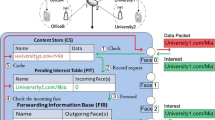Abstract
In WSN, a mobile node needs to depend on intermediate mobile nodes to achieve content acquisition. Due to the mobility of nodes and the big size of multimedia content, it is significant to shorten content acquisition latency in WSN. This paper extends multihoming to WSN and aims to take advantage of multihoming to reduce content acquisition latency. In order to solve the multiple address configuration issue in multihoming, this paper proposes the address separation mechanism. Based on this mechanism, a mobile node can be configured with multiple addresses via one addressing process, so the addressing latency can be substantially reduced. In order to take advantage of multihoming to achieve content acquisition, this paper extends the k-anycast communication model to WSN so that a mobile node can use multiple addresses with different network prefixes to acquire different parts of one kind of content from multiple optimal k-anycast members in parallel. Consequently, the content acquisition latency can be reduced. This proposal is evaluated and the data results show that the content acquisition latency is shortened.




Similar content being viewed by others
References
Wang, X., Cheng, H., & Yao, Y. (2016). Addressing-based routing optimization for 6LoWPAN WSN in vehicular scenario. IEEE Sensors Journal, 16(10), 3939–3947.
Wang, X., & Zhu, X. (2018). Anycast-based content-centric MANET. IEEE Systems Journal. https://doi.org/10.1109/JSYST.2016.2619374.
Fang, C., Yu, F. R., Huang, T., & Liu, J. (2015). A survey of green information-centric networking: Research issues and challenges. IEEE Communications Surveys & Tutorials, 17(3), 1455–1472.
Detti, A., Tassetto, D., Melazzi, N. B., & Fedi, F. (2015). Exploiting content centric networking to develop topic-based, publish–subscribe MANET systems. Ad Hoc Networks, 24, 115–133.
Lu, Y., Li, X., Yu, Y. T., & Gerla, M. (2014). Information-centric delay-tolerant mobile ad-hoc networks. In 2014 IEEE conference on computer communications workshops (INFOCOM WKSHPS) (pp. 428–433). IEEE.
Yu, D., Wang, Y., Yan, Y., Yu, J., & Lau, F. C. (2015). Speedup of information exchange using multiple channels in wireless ad hoc networks. In 2015 IEEE Conference on Computer Communications (INFOCOM) (pp. 2029–2037). IEEE.
Troan, O., Miles, D., Matsushima, S., Okimoto, T., & Wing, D. (2014). IPv6 multihoming without network address translation. IETF RFC 7157.
Kuntz, R., Montavont, J., & Noel, T. (2013). Multihoming in IPv6 mobile networks: Progress, challenges, and solutions. Communications Magazine, IEEE, 51(1), 128–135.
Gladisch, A., Daher, R., & Tavangarian, D. (2014). Survey on mobility and multihoming in future internet. Wireless Personal Communications, 74(1), 45–81.
Wu, W., Wang, J., Li, M., Liu, K., & Luo, J. (2015). Energy-efficient transmission with data sharing. In 2015 IEEE conference on computer communications (INFOCOM) (pp. 73–81). IEEE.
Droms, R., Bound, J., Volz, B., Lemon, T., Perkins, C., & Carney, M. (2003). Dynamic host configuration protocol for IPv6 (DHCPv6). RFC 3315.
Nesargi, S., & Prakash, R. (2002). MANETconf: Configuration of hosts in a mobile ad hoc network. In Twenty-first annual joint conference of the IEEE computer and communications societies. Proceedings INFOCOM 2002, IEEE (Vol. 2, pp. 1059–1068). IEEE.
Kim, S. C., & Chung, J. M. (2008). Message complexity analysis of mobile ad hoc network address autoconfiguration protocols. IEEE Transactions on Mobile Computing, 7(3), 358–371.
Hinden, R. M., & Deering, S. E. (2006). IP version 6 addressing architecture. IETF RFC 4291.
Lai, W. K., Shieh, C. S., & Chou, K. P. (2009). Improving handover performance by switching between unicast and multicast addressing. IEEE Transactions on Wireless Communications, 8(3), 1238–1246.
Wang, X. (2008). Analysis and design of a k-anycast communication model in IPv6. Computer Communications, 31(10), 2071–2077.
Han, S. Y., & Lee, D. (2013). An adaptive hello messaging scheme for neighbor discovery in on-demand MANET routing protocols. IEEE Communications Letters, 17(5), 1040–1043.
Kniess, J., Loques, O., & Albuquerque, C. V. (2009). Location aware discovery service and selection protocol in cooperative mobile wireless ad hoc networks. In INFOCOM workshops 2009, IEEE (pp. 1–2). IEEE.
Wang, X. (2016). A mobility frame for 6LoWPAN WSN. IEEE Sensors Journal, 16(8), 2755–2762.
Camp, T., Boleng, J., & Davies, V. (2002). A survey of mobility models for ad hoc network research. Wireless Communications and Mobile Computing, 2(5), 483–502.
Acknowledgements
This work is supported by Jiangsu Nature Science Foundation (BK20141230) and “333 Project” Foundation (BRA2016438).
Author information
Authors and Affiliations
Corresponding author
Additional information
Publisher's Note
Springer Nature remains neutral with regard to jurisdictional claims in published maps and institutional affiliations.
Rights and permissions
About this article
Cite this article
Wang, X., Wang, D. & Dou, Z. Efficient Content Acquisition in WSN. Wireless Pers Commun 108, 461–472 (2019). https://doi.org/10.1007/s11277-019-06411-0
Published:
Issue Date:
DOI: https://doi.org/10.1007/s11277-019-06411-0




